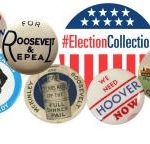Students will analyze a political cartoon depicting Dr. Martin Luther King Jr. and the title of his famous speech, “I Have a Dream.” Discussion of the meaning of the cartoon leads into a more general conversation about rights and equality.
Judicial Nominations
Conversation starter using a political cartoon, which compares the public’s interest in judicial nominations with contestants on the television show “American Idol.”
Debate Watching Guide

This lesson is designed to help students view political debates. The resources provided support the critical evaluation of the candidate’s performances. Body language, demeanor, appearance and positions on key issues are analyzed in an attempt to help students determine the importance of debates to the election cycle. This lesson could be used in class or as a homework assignment.
Presidential Campaign Memorabilia on DocsTeach

This page includes a variety of primary sources in the form of artifacts, photographs, documents, and more; as well as additional online resources. Themes highlight political memorabilia from presidential campaigns from the 1850s through the 1990s. Items come from the holdings of the Presidential Libraries of the National Archives.
Search and Seizure Cartoon Analysis
Spark a conversation about the balance between national security and Fourth Amendment rights with this quick cartoon of Lady Liberty.